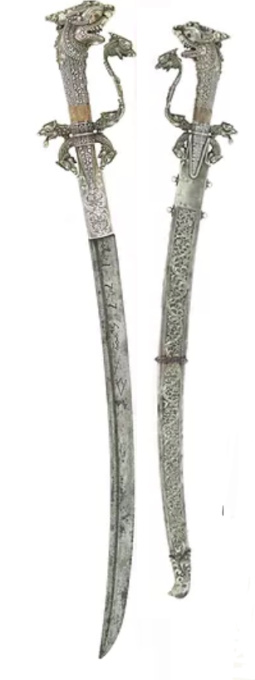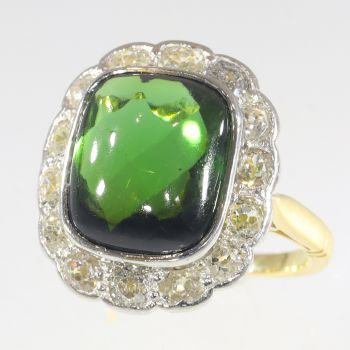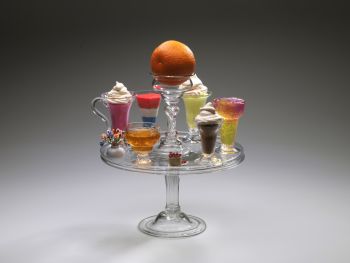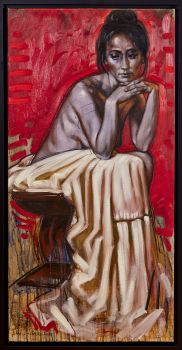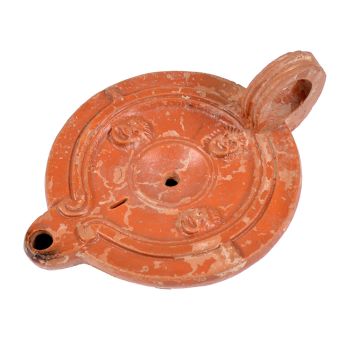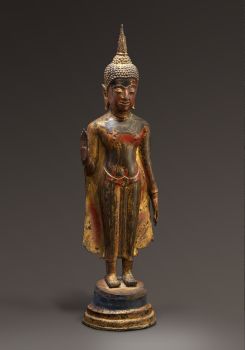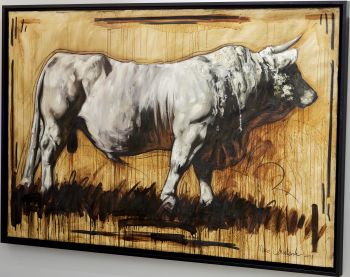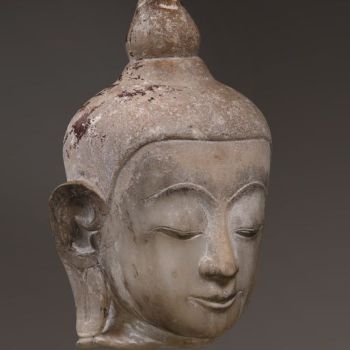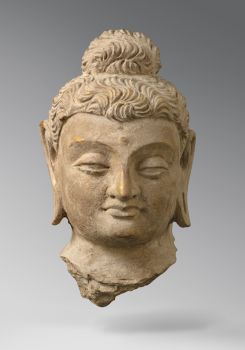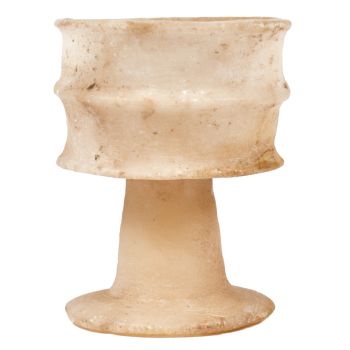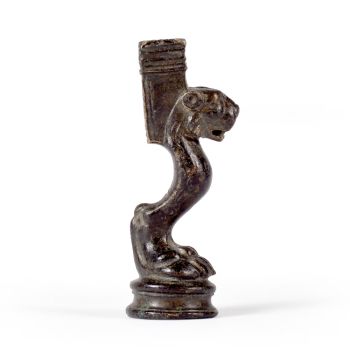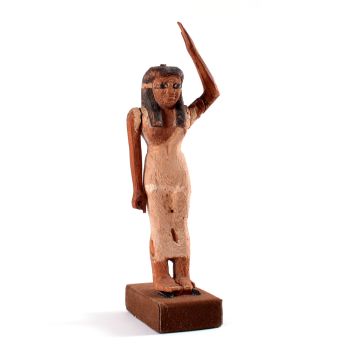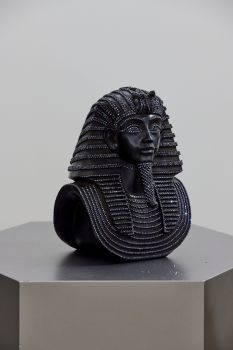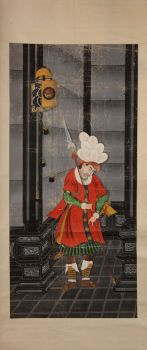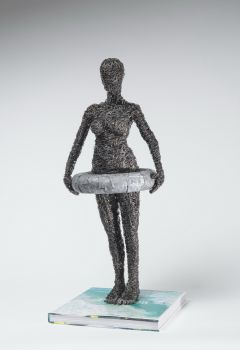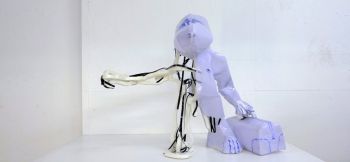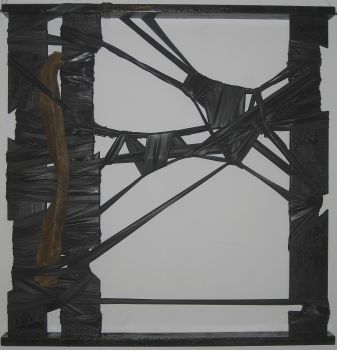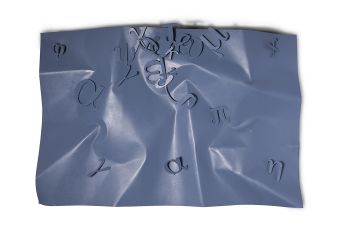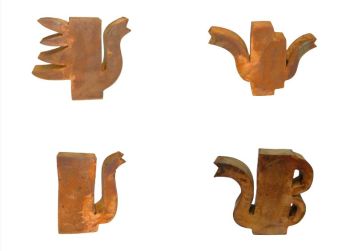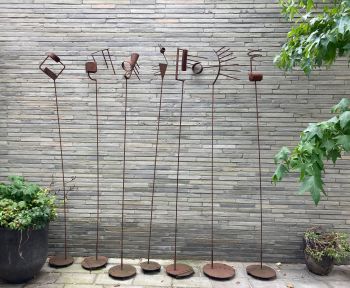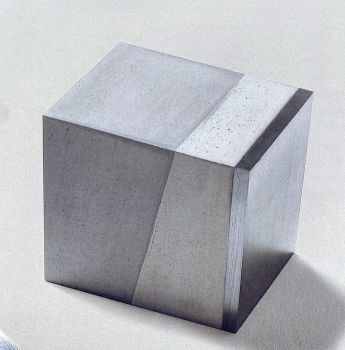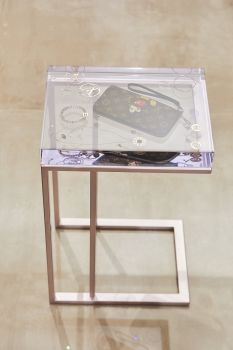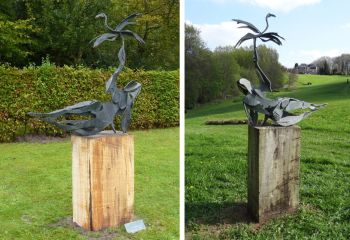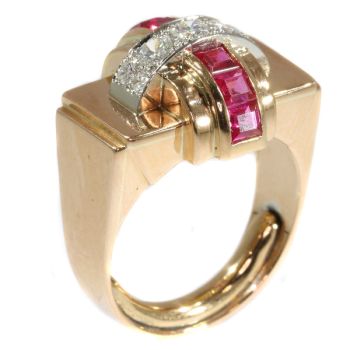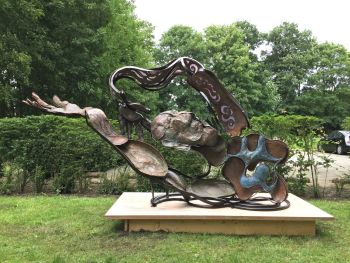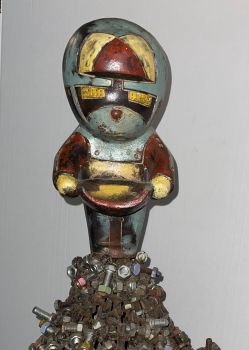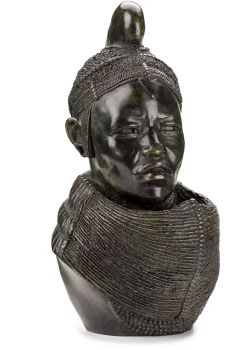A fine ruby inlaid iron, steel, silver, brass, gold Sinhalese Kasthane 1776
Unbekannter Künstler
EisenRubinStahlGoldMetallEdelstein
100 ⨯ 67 ⨯ 47 cm
Derzeit nicht über Gallerease verfügbar
Zebregs & Röell - Fine Art - Antiques
- Über KunstwerkA fine ruby inlaid iron, steel, silver, brass, gold Sinhalese Kasthane
Kingdom of Kandy, Sri Lanka (Ceylon), the blade marked VOC Amsterdam and dated 1776, the hilt late 18th century
L. 100.5 x W. 67 x H. 47 cm
A beautiful silver-mounted kasthāné with a narrow, curved blade with a single groove on each side. The blade bears the V.O.C. Amsterdam cipher on either side, with the year 1776. Many such marked blades are found all over the former colonies, including Sumatra and Java. It is unclear how they were obtained, as the V.O.C. was not officially selling the blades in these areas. Unlike many highly ornamental kasthāné that are purely ceremonial, this blade is a decent piece capable of actual use.
The silver hilt is typical Sinhalese. Cast out of two halves and worked to finer detail with chiselling in traditional Sinhalese motifs, with remains of parcel gilding. It has the large simha (lion) head pommel with ruby pupils set in gilt copper eyes. The grip is articulated with cutouts for the fingers, leading up to an octagonal gilt copper ferrule.
The crossbar terminates in a sérapéṅdiya on one side, the other side has a makara head from which the knucklebow emerges, which in turn ends in another sérapéṅdiya head. On the front of the knucklebow is a figure of Lakshmi, goddess of abundance and fortune. She is sat in the lotus position, holding two sprays of vegetation. Above the guard section emergy two makara heads, they neck leading their heads back towards the base of the blade.
The wooden scabbard is clad in silver, worked in repousse with traditional Sinhalese liya-vela, a decorative repetitive vegetal motif that sprouts from the head of a sérapéṅdiya near the tip. The scabbard endpiece is a highly stylized bird's head, with liya-pata, Sinhalese traditional curly elements.
The scabbard has a band in the middle beset with 13 pink rubies. Near the mouthpiece is engraved ".A:M.", repeated in the knucklebow. Possibly the initials of a previous owner. By the late 18th century, the western script was adopted in Sri Lanka as well, and male names often started with an A so it could have well been the initials of a local. The scabbard has four loops by which it was attached to a sash worn diagonally over the body.
A very nice example of a classic Sinhalese kasthāné of the silver type that was presented by the king of Kandy to Adigar at their appointment. It has the rare and desirable additions of a band of rubies on the scabbard and a dated, V.O.C. marked blade that put it firmly in the 18th century. In addition, there are initials that may help a future owner in further investigating the sword's context. - Über Künstler
Es kann vorkommen, dass ein Künstler oder Hersteller unbekannt ist.
Bei einigen Werken ist nicht zu bestimmen, von wem sie hergestellt wurden, oder sie wurden von (einer Gruppe von) Handwerkern hergestellt. Beispiele sind Statuen aus der Antike, Möbel, Spiegel oder Signaturen, die nicht klar oder lesbar sind, aber auch einige Werke sind überhaupt nicht signiert.
Außerdem finden Sie folgende Beschreibung:
•"Zugeschrieben …." Ihrer Meinung nach wohl zumindest teilweise ein Werk des Künstlers
•„Atelier von ….“ oder „Werkstatt von“ Ihrer Meinung nach eine Arbeit, die im Atelier oder in der Werkstatt des Künstlers, möglicherweise unter seiner Aufsicht, ausgeführt wurde
•„Kreis von ….“ Ihrer Meinung nach ein Werk aus der Zeit des Künstlers, das seinen Einfluss zeigt, eng mit dem Künstler verbunden, aber nicht unbedingt sein Schüler
•"Art von …." oder „Anhänger von ….“ Ihrer Meinung nach eine Arbeit, die im Stil des Künstlers ausgeführt wurde, aber nicht unbedingt von einem Schüler; kann zeitgenössisch oder fast zeitgenössisch sein
•„Art von ….“ Ihrer Meinung nach ein Werk im Stil des Künstlers, aber späteren Datums
•"Nach …." Ihrer Meinung nach eine Kopie (jegliches Datums) eines Werks des Künstlers
• „Unterzeichnet …“, „Datiert …“. oder „Beschriftet“ Ihrer Meinung nach wurde das Werk vom Künstler signiert/datiert/beschriftet. Das Hinzufügen eines Fragezeichens weist auf einen Zweifel hin
• „Mit Unterschrift …“, „Mit Datum …“, „Mit Aufschrift ….“ oder „Trägt Unterschrift/Datum/Beschriftung“ ihrer Meinung nach die Unterschrift/Datum/Beschriftung von jemand anderem als dem Künstler hinzugefügt wurde
Sind Sie daran interessiert, dieses Kunstwerk zu kaufen?
Artwork details
Related artworks
Unbekannter Künstler
Zwei Studienporträts von Mas Marco Kartodikromo1900 - 1950
Preis auf AnfrageZebregs & Röell - Fine Art - Antiques
Unbekannter Künstler
Frühe Art-Deco-Brosche1920
Preis auf AnfrageAns Hemke-Kuilboer Juwelier & Antiquair
Unbekannter Künstler
Salver oder Tazza mit Orangenglas, Gelee und Puddinggläsern.1750 - 1755
Preis auf AnfragePeter Korf de Gidts - Antiquairs
1 - 4 / 12Unbekannter Künstler
The bell of the VOC fortress in Jaffna, Sri Lanka1747
Preis auf AnfrageZebregs & Röell - Fine Art - Antiques
 Kuratiert von
Kuratiert vonDanny Bree
1 - 4 / 16Unbekannter Künstler
EIN JAPANISCHES MODELL EINES NORIMONO, EINES PALANQUINS1650 - 1700
Preis auf AnfrageZebregs & Röell - Fine Art - Antiques
Unbekannter Künstler
A silver spoon commemorating Juff’ Margareta van Hoorn1656 - 1694
Preis auf AnfrageZebregs & Röell - Fine Art - Antiques
Shiba Kokan
Gemälde eines Fantasy-Holländersearly 19th
Preis auf AnfrageZebregs & Röell - Fine Art - Antiques
1 - 4 / 24- 1 - 4 / 24
Dutch School
Ankunft eines niederländischen Ostindianers in der Table Bay18th century
Preis auf AnfrageZebregs & Röell - Fine Art - Antiques
Unbekannter Künstler
A rare Japanese export lacquer medical instrument box1650 - 1700
Preis auf AnfrageZebregs & Röell - Fine Art - Antiques
Unbekannter Künstler
Holländer in Miniatur (Netsuke)1700 - 1900
Preis auf AnfrageZebregs & Röell - Fine Art - Antiques
Unbekannter Künstler
A large Japanese Imari porcelain 'VOC Groningen' dish1800 - 1925
Preis auf AnfrageZebregs & Röell - Fine Art - Antiques
1 - 4 / 12

